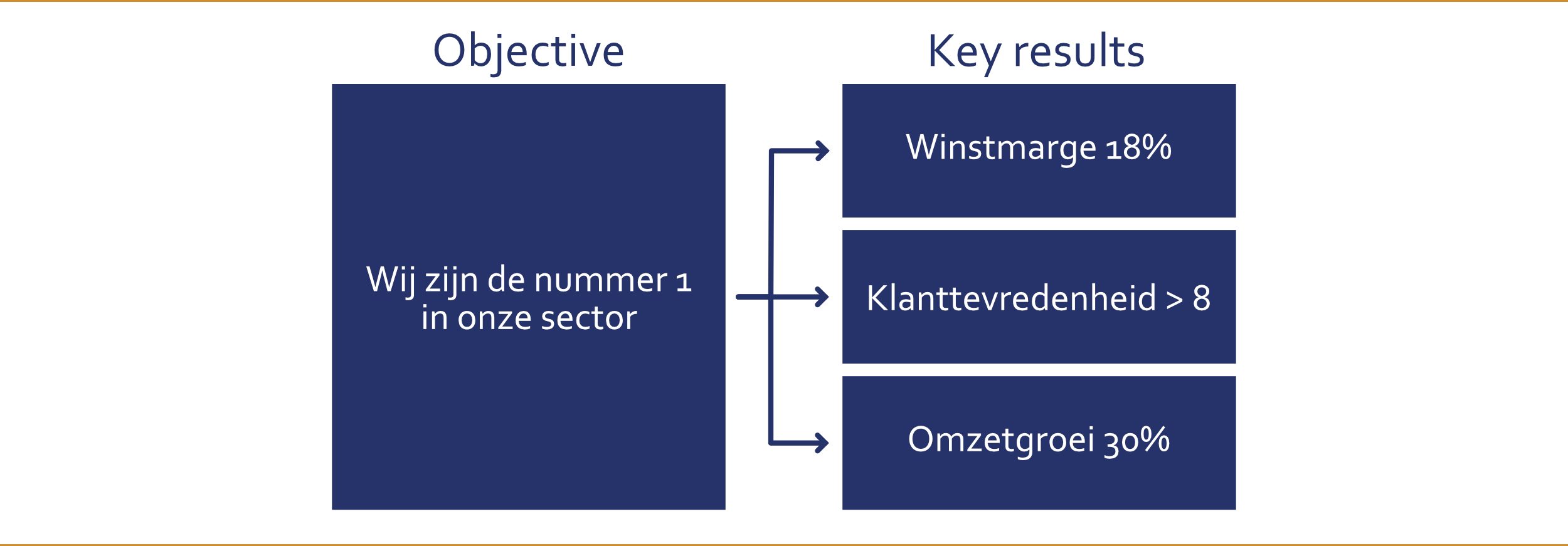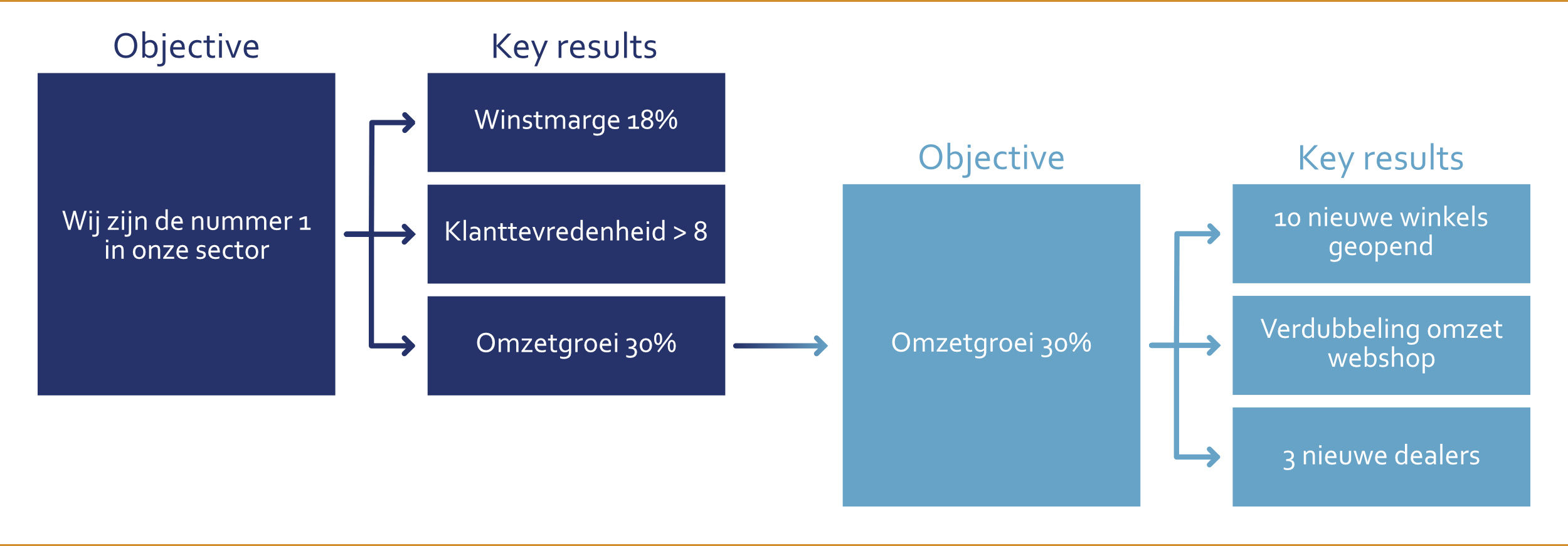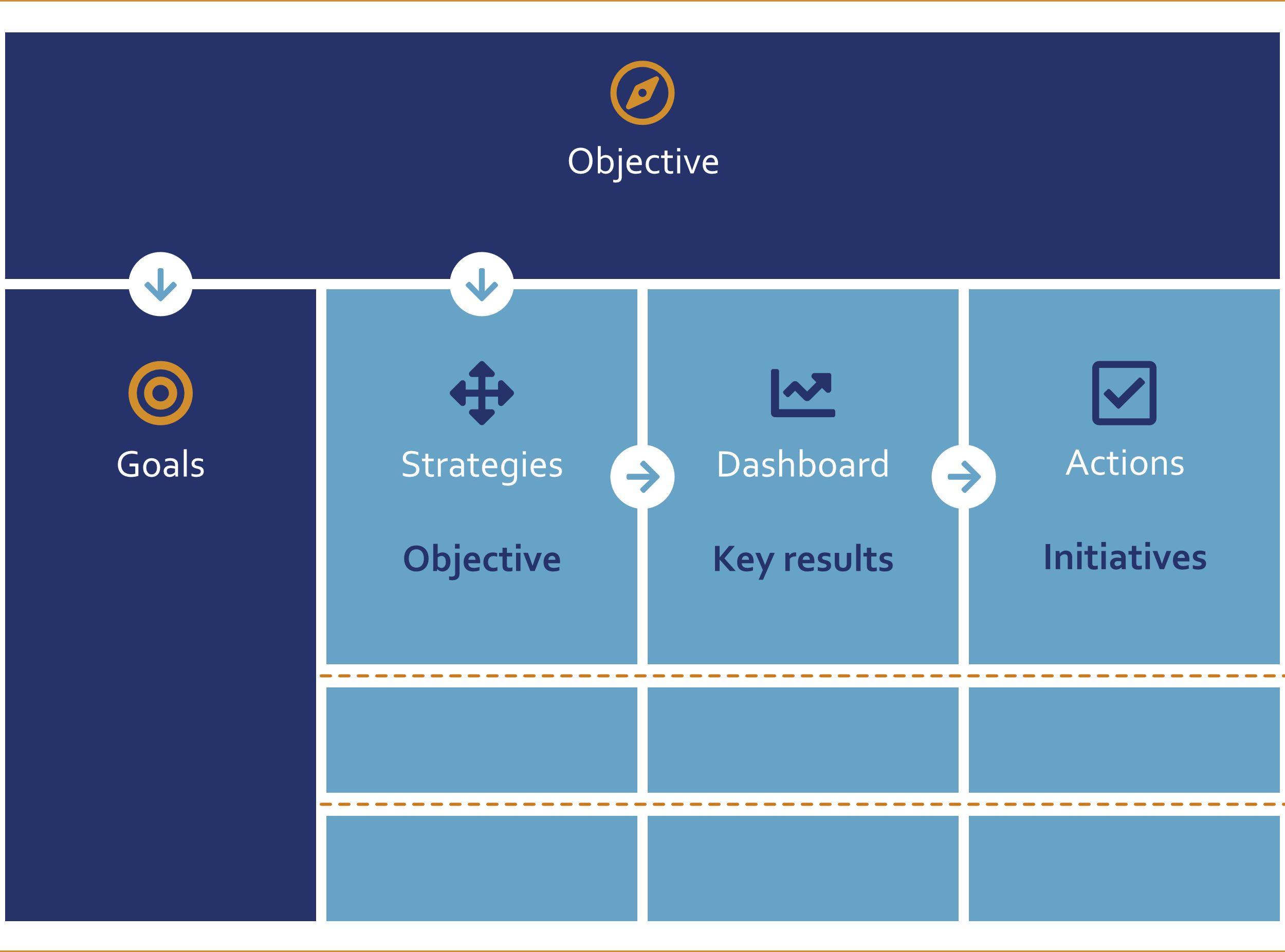OKR stands for Objective and Key Results
The two parts of OKRs are:
- Objective: the goal you want to achieve. Described as concretely as possible, so that the goal is clear to all involved.
- Key Results: the indicators or concrete results that you gradually monitor to determine progress. They are measurable and unambiguous. You can therefore indicate exactly whether a Key Result has been achieved. You prepare about 3 to 5 Key Results per Objective.

With OKRs you make the goals explicit and you can monitor progress. Both aspects contribute enormously to the realization of the goals.
From goals to action
Strictly speaking, OKRs consist only of an objective and key results. In practice, a third component is sometimes added: Initiatives. These are the concrete actions to achieve the set results and goals.
Combination of output and input
The OKR method distinguishes between output and input. An OKR for the output describes the final result you are aiming for. Take, for example, a turnover growth of 30%.
An OKR for the input does not describe an ultimate goal, but a means, the how. E.g. opening 10 new stores (which together generate revenue growth).
Both forms of OKRs have a function. The output focuses the team members on what matters: why do we do the things we do? However, the input is more concrete and easier to measure.
You often see that OKRs higher in the organization are more focused on output, and lower in the organization more on input.
A article at whatmatters.com (the website of OKR evangelist John Doerr) describes the combination of output and input as a “key difference” with OGSM. OGSMs would often contain financial goals. However, practice shows otherwise. OGSM is ideal for combining output and input in one overview. The output is (mainly) expressed in the goals (goals). The input is mainly reflected in the indicators (measures). Moreover, the goals are never purely financial in nature. For example, customers, employees and sustainability are often reflected in the goals.
Hard goals and (un) feasible objectives
Interesting is the distinction between “committed” and “aspirational” OKRs. The first variant must be achieved. The owner is committed to the success of the OKR and can be held accountable for it. The second variant expresses the objective of the organization and aims to challenge and inspire those involved. There is a chance that we will not make it, but suppose we succeed ...
In OGSMs you can make the same distinction in the indicators (which often describe the annual goals of a team).
Learn and adjust every quarter
Quarters are a common rhythm for learning and adjusting OKRs. Each quarter you determine whether the Objectives have been realized and you determine the OKRs for the coming quarter. As a team it is possible to work in parallel on several OKRs.
During the quarter, for example every month, you evaluate the progress of the OKR and determine whether the OKR will be continued or whether it needs to be adjusted. In this way you learn from your experiences and you can adapt to changing circumstances.
OKRs are aimed at contributing to the strategy of the organization, but with a horizon of (usually) a quarter. OKRs are therefore naturally more agile than OGSMs and fit in an environment with extreme dynamics.
OGSMs are more systematic than OKRs. An OGSM is a detailed plan with a horizon that is (usually) a number of years away. Due to its systematic nature, OGSM helps to better prioritize the various activities. OGSM provides an overview of the bigger picture and the relationship between strategies. The long-term plan is developed into concrete actions in the short term. However, through a method of learning and adjusting, the OGSM remains a living plan, so that you keep track and remain agile.
Our working method with monthly and quarterly sessions is in line with the working method of OKRs. The Objective and Goals are often focused on the long term, but the Strategies, Indicators and Actions are flexible.
Coherence between OKRs in the organization
To ensure coherence with the long-term goals of the organization, you can cascade OKRs, in other words: translate them to deeper levels in the organization. In the example below you can see a cascaded OKR and how it also becomes more input-oriented.

The method implies that the OKRs are transparent for the entire organization. In this way you stimulate that OKRs contribute deeper in the organization to the greater whole and that the initiatives of different departments and teams are coordinated.
OGSMs can be cascaded in a similar way, with the Actions of the organizational OGSM forming the Strategies in the department OGSMs. Although we are more in favor of cascading based on the Strategies. The departments themselves determine the formulation of the Strategies. In it they describe how they contribute to the organizational OGSM. This creates more ownership and support.
OGSM vs. OKR
They are two different methods with the same goal: getting results. The table below provides an overview of the differences.
| OKR | OGSM | |
|---|---|---|
| Focus | The Objective gives a clear focus to those involved. | The Objective determines the direction for the long term. The Strategies focus on the shorter term (often one year). |
| From goals to action | You can add Initiatives to the OKR. | Actions are an inseparable part of the OGSM. |
| Progress | With the Key results you can monitor progress. | The Indicators on the Dashboard provide insight into the progress of the strategy. |
| Learning and adjusting | You prepare new OKRs every quarter. The condition is that they contribute to the mission / vision / strategy. | The OGSM is a living plan. You evaluate the results and update the plan every quarter. |
| Hard goals and big challenges | Both “committed” and “aspirational” OKR's possible. | On the dashboard you can distinguish between hard goals (in OGSM terms: target values) and “aspirational” goals. |
| Combination of output and input | OKRs can be both output and input oriented. | Goals are output-oriented, the indicators more input-oriented. |
| Cohesion in the organization | Cascading of OKRs is possible. | Cascading of OGSMs is possible. |
| Scheduled vs. ad hoc | OKRs are very flexible and are drawn up quarterly. In extreme cases this leads to ad hoc activities. | OGSMs are usually drawn up per year and adjusted along the way. In extreme cases, the plan is held too rigidly. |
OGSM and OKR: the best of both worlds
OGSM and OKR are therefore different methods, but with a large overlap. It also just depends on how you apply the method. The figure below shows how OGSM and OKR can coincide.
- The Objective and Goals of the OGSM form the long-term perspective, they safeguard the view on the long term.
- The Strategies are comparable to the Objective in the OKR.
- The Dashboard with indicators is similar to the Key results. However, the name 'Key results' is more helpful. Determining indicators on the Dashboard is often difficult. Thinking about the concrete results you are aiming for makes this easier.
- The Actions correspond to the Initiatives.
- Strategic choices and Indicators (and actions) form the OKR for the short term. This term is often one year, with which the OGSM forms the annual plan.

Planning is strategic at an organizational level. The emphasis in the OGSM is on the Objective, Goals and Strategies.
In underlying departments and teams, the emphasis is more on the Strategic choices, Indicators and Actions. These plans are more tactical and operational in nature. In practice, we see that deeper in the organization, separate Objective and separate Goals are not always formulated. So you could say that only OKRs are drawn up here.
In this way, OGSM and OKR are not two different methods, but two methods that reinforce each other. Where the focus on the longer term is important, you use the full OGSM. Where that is less important, leave the Objective and Goals blank, or use the parent content.
Among other things, the book was used to write this article Measure what matters from John Doerr and the website whatmatters.com from John Doerr's company.


